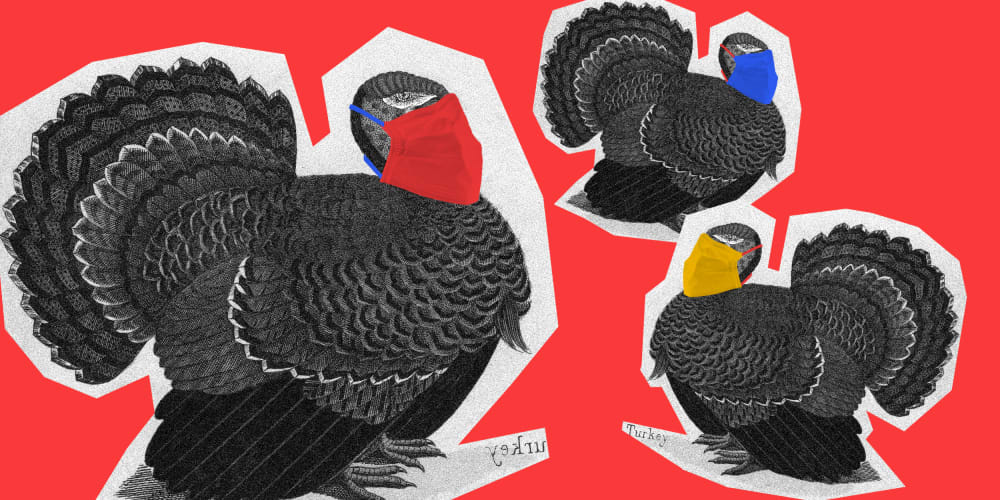The impact of the nation’s Covid-19 cases — over 10 million and counting, with more than 250,000 dead — have many people considering how best to avoid the virus during the holiday season. The Centers for Disease Control and Prevention, along with the members of the White House coronavirus task force, including Dr. Anthony Fauci, and most health professionals including myself, have urged everyone to reconsider plans and stay home. Staying home equals saving lives. Fauci and his wife, Christine Grady, discussed their own decision to celebrate the Thanksgiving holiday without their two daughters.
But we also acknowledge that at least 50.6 million Americans are planning to travel soon, or to invite other family and friends into your home. If this group includes you, you should consider these practical tips to keep yourself and others healthy and as safe as possible:
1. Not all masks are created equal
Despite the unfortunate political rhetoric that has emerged about masks, the science is clear: The respiratory aspect of this virus can be mitigated to a large degree by wearing high quality masks.
If you can wear your mask and blow out a birthday candle, your mask should be replaced.
How can you tell if you have a good mask? Try the candle test: If you can wear your mask and blow out a birthday candle, your mask should be replaced, ideally with a three layer mask. Also remember, wearing the mask on your mouth only is not good enough; it must cover your nose and mouth in order to serve its purpose. Healthcare-grade masks such as N-95 masks require proper fitting (a complex process that is done under pretty strict environmental conditions) and are best reserved for health care workers as these are still in short supply, but many high quality alternatives are available.
Wearing a mask indoors may seem unconventional, but try to at least encourage higher risk people to wear a mask, especially older people, pregnant women and people with chronic conditions. If you are visiting others or hosting guests, keep a spare supply of masks that people can use if they forget theirs, or if you notice that theirs is of lesser quality. If one thing is certain, it’s that, for the foreseeable future at least, masks are here to stay. Instead of focusing on how scary it feels, incorporate masks into your holiday traditions. We can even make them fun; create a contest for the most creative mask, or have a mask-decorating party along with you usual holiday activities to help normalize the concept of wearing one in your house.

2. To test or not to test?
Many of my patients have asked whether they should take a Covid-19 test prior to travel, and if a negative result means safe travel. Keep in mind that not all tests are created equal. Many of the rapid tests that offer results in less than an hour suffer from high false negative rates, while the lab-based PCR tests which are close to 100 percent accurate can take several days to process, and often involve standing with strangers in long lines to get into testing centers.
Similar to a pregnancy test, you can test too early to detect results, but still be pregnant.
If you decide to go this route, the best course of action is to take a test and then immediately quarantine for at least 14 days, then consider testing again at day 10. Since we are getting so close to Thanksgiving Day, I encourage my patients to remember that tests only offer a snapshot of the results in that exact moment that you obtained the test.
Similar to a pregnancy test, you can test too early to detect results, but still be pregnant. If you do choose to test in order to travel, please be sure you get a high quality test and try to quarantine as long as possible to prevent the chances of receiving or getting the virus. Quarantining is still the most important factor, no matter your testing protocol.
3. Can you control your environment?
In the clinic and hospital, our humidity is controlled, there is a sink in every room, and you can’t walk 5 feet without seeing a hand sanitizer dispenser. In essence, our built environment is tailored to avoid respiratory spread. Our homes are almost the opposite for the most part: The air in our homes circulates about 1-2 times an hour and the cold air combined with low humidity makes it easier for virus particles to linger. In addition to wearing masks, do what you can to build a better equipped home. Have frequent sanitizing stations and provide masks and disinfectant wipes. Consider how to move air inside a room by either opening a window or using some practical techniques to improve air circulation.
The air in our homes circulates about 1-2 times an hour and the cold air combined with low humidity makes it easier for virus particles to linger.
In my household, we space chairs so that we’ve gotten used to understanding how far 6 feet actually is. Of course, this means we also have to keep in mind that if you are speaking with raised, loud voices because of large distances between people, you’re likely emitting more particles that linger in the air. Surfaces should be kept clean in the house, especially high traffic areas like counters. Use gloves when handling dishes, and ask guests to bring and take their own plates. The safest option for all involved is to host your holiday meal outdoors.













